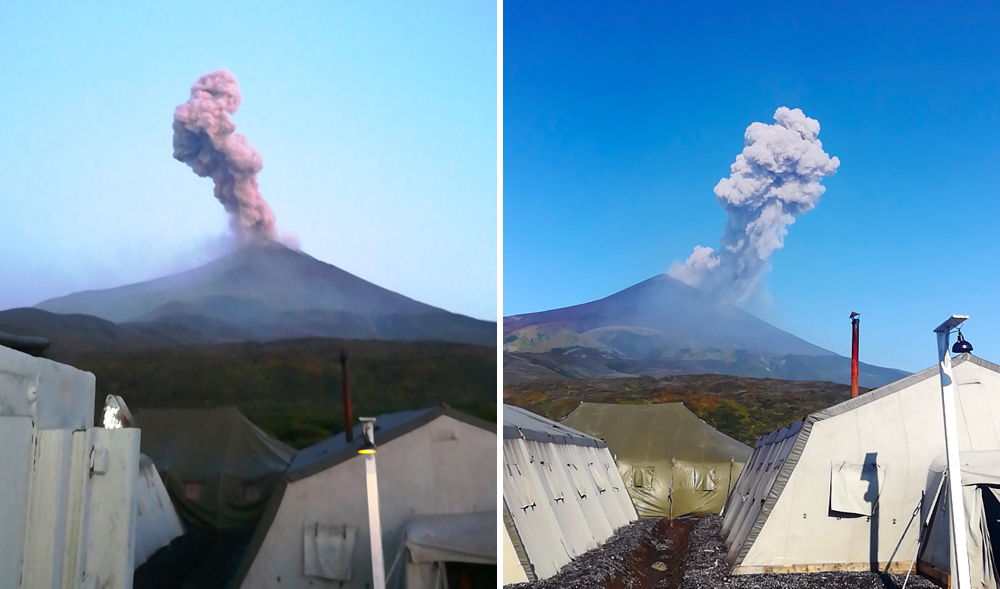Report on Sarychev Peak (Russia) — June 2019
Bulletin of the Global Volcanism Network, vol. 44, no. 6 (June 2019)
Managing Editor: Edward Venzke.
Edited by A. Elizabeth Crafford.
Sarychev Peak (Russia) Brief ash emission reported on 16 May 2019
Please cite this report as:
Global Volcanism Program, 2019. Report on Sarychev Peak (Russia) (Crafford, A.E., and Venzke, E., eds.). Bulletin of the Global Volcanism Network, 44:6. Smithsonian Institution. https://doi.org/10.5479/si.GVP.BGVN201906-290240
Sarychev Peak
Russia
48.092°N, 153.2°E; summit elev. 1496 m
All times are local (unless otherwise noted)
Located on Matua Island in the central Kurile Islands of Russia, Sarychev Peak has historical observations of eruptions dating back to 1765. Thermal activity in October 2017 (BGVN 43:11) was the first sign of renewed activity since a major eruption with ash plumes and pyroclastic flows in June 2009 (BGVN 34:06). The following month (November 2017) there was fresh dark material on the NW flank that appeared to be from a flow of some kind. After that, intermittent thermal anomalies were the only activity reported until explosions with ash plumes took place that lasted for about a week in mid-September 2018 (figure 24). Additional explosions in mid-October were the last reported for 2018. A single ash explosion in May 2019 was the only reported activity from November 2018 to May 2019, the period covered in this report. Information is provided by the Sakhalin Volcanic Eruption Response Team (SVERT) and the Kamchatka Volcanic Eruptions Response Team (KVERT), members of the Far Eastern Branch, Russian Academy of Sciences (FEB RAS), and from satellite data.
 |
Figure 24. Multiple ash plumes were observed at Sarychev Peak during September 2018. Left: 13 September. Right: 18 September. Photos by S. A. Tatarenkov, courtesy of IMGG FEB RAS. |
Satellite imagery in mid-September and early October 2018 showed gas emissions from the summit vent, and a weak thermal anomaly in October (figure 25). KVERT lowered the Aviation Color Code from Orange to Yellow on 1 November 2018, and SVERT released a VONA on 12 November 2018 lowering the Aviation Color Code from Yellow to Green after the ash emissions in October.
Sentinel-2 satellite instruments in March, April, and May 2019 acquired images that showed dark streaks in the snow-covered peak radiating out from the summit vent in various directions. As the spring snows melted, more dark streaks appeared. It is unclear whether the streaks represent fresh ash, particulates from gas emissions in the snow, or concentrated material from earlier emissions that were exposed during the spring melting (figure 26). No further activity was reported until the Tokyo VAAC noted an eruption on 16 May 2019 that produced an ash plume which rose to 2.4 km altitude and drifted S. It was visible in satellite imagery for 3 or 4 hours before dissipating. SVERT reported the ash plume visible up to 50 km SE of the island. They also noted that weak thermal anomalies had been seen in satellite data on 10, 12, and 17 May 2019.
Geological Summary. Sarychev Peak, one of the most active volcanoes of the Kuril Islands, occupies the NW end of Matua Island in the central Kuriles. The andesitic central cone was constructed within a 3-3.5-km-wide caldera, whose rim is exposed only on the SW side. A dramatic 250-m-wide, very steep-walled crater with a jagged rim caps the volcano. The substantially higher SE rim forms the 1496 m high point of the island. Fresh-looking lava flows, prior to activity in 2009, had descended in all directions, often forming capes along the coast. Much of the lower-angle outer flanks of the volcano are overlain by pyroclastic-flow deposits. Eruptions have been recorded since the 1760s and include both quiet lava effusion and violent explosions. Large eruptions in 1946 and 2009 produced pyroclastic flows that reached the sea.
Information Contacts: Institute of Marine Geology and Geophysics, Far Eastern Branch of the Russian Academy of Sciences, (FEB RAS IMGG), 693 022 Russia, Yuzhno-Sakhalinsk, ul. Science 1B (URL: http://imgg.ru/ru); Sakhalin Volcanic Eruption Response Team (SVERT), Institute of Marine Geology and Geophysics, Far Eastern Branch, Russian Academy of Science, Nauki st., 1B, Yuzhno-Sakhalinsk, Russia, 693022 (URL: http://www.imgg.ru/en/, http://www.imgg.ru/ru/svert/reports); Kamchatka Volcanic Eruptions Response Team (KVERT), Far Eastern Branch, Russian Academy of Sciences, 9 Piip Blvd., Petropavlovsk-Kamchatsky, 683006, Russia (URL: http://www.kscnet.ru/ivs/kvert/); Tokyo Volcanic Ash Advisory Center (VAAC), 1-3-4 Otemachi, Chiyoda-ku, Tokyo, Japan (URL: http://ds.data.jma.go.jp/svd/vaac/data/); Sentinel Hub Playground (URL: https://www.sentinel-hub.com/explore/sentinel-playground).



